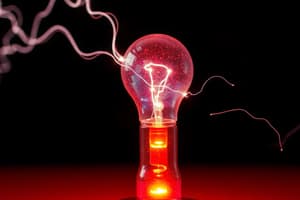Podcast
Questions and Answers
What is the significance of the critical temperature of a gas?
What is the significance of the critical temperature of a gas?
- It indicates the pressure required to liquefy the gas.
- It determines the volume of one mole of the gas.
- It represents the temperature at which a gas cannot be liquefied.
- It measures the attractive forces between molecules. (correct)
Which method involves subjecting a gas to intense coldness to liquefy it?
Which method involves subjecting a gas to intense coldness to liquefy it?
- Joule Thomson effect
- Faraday's method
- Claude's method
- Linde's method (correct)
How does compression contribute to liquefaction of gases?
How does compression contribute to liquefaction of gases?
- It decreases the critical temperature of the gas.
- It decreases the attractive forces between molecules.
- It increases the kinetic energy of the molecules.
- It brings the molecules close together. (correct)
How does a decrease in temperature affect the liquefaction of gases?
How does a decrease in temperature affect the liquefaction of gases?
In which method is compression used as a means to achieve liquefaction?
In which method is compression used as a means to achieve liquefaction?
Which technique involves both cooling and compression to achieve gas liquefaction?
Which technique involves both cooling and compression to achieve gas liquefaction?
What is the outcome of a gas being cooled in terms of kinetic energy and molecular velocity?
What is the outcome of a gas being cooled in terms of kinetic energy and molecular velocity?
Which physical condition influences the transformation of a gaseous substance into liquid state?
Which physical condition influences the transformation of a gaseous substance into liquid state?
What happens to the pressure required to liquefy a gas with an increase in temperature?
What happens to the pressure required to liquefy a gas with an increase in temperature?
What is the critical temperature of a gas?
What is the critical temperature of a gas?
Which method involves applying pressure to a gas to bring the molecules within the sphere of van der Waals forces for liquefaction?
Which method involves applying pressure to a gas to bring the molecules within the sphere of van der Waals forces for liquefaction?
In the context of liquefaction, what does the critical pressure represent?
In the context of liquefaction, what does the critical pressure represent?
What causes the drop in temperature in the Joule Thomson effect?
What causes the drop in temperature in the Joule Thomson effect?
How is liquid oxygen obtained based on the Joule Thomson effect?
How is liquid oxygen obtained based on the Joule Thomson effect?
How does Linde's method differ from Faraday's method in terms of liquefaction?
How does Linde's method differ from Faraday's method in terms of liquefaction?
What is the purpose of Claude's apparatus in the liquefaction process?
What is the purpose of Claude's apparatus in the liquefaction process?
What role does the fine orifice play in the Joule Thomson effect?
What role does the fine orifice play in the Joule Thomson effect?
Why does expansion of gas molecules lead to cooling in the Joule Thomson effect?
Why does expansion of gas molecules lead to cooling in the Joule Thomson effect?
Flashcards are hidden until you start studying




